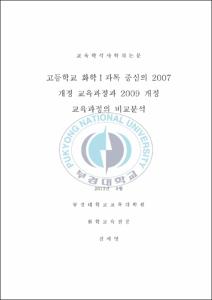고등학교 화학Ⅰ과목 중심의 2007 개정 교육과정과 2009 개정 교육과정의 비교분석
- Abstract
- A comparative analysis of the Curriculum Revision 2009 with the Curriculum Revision 2007: Focusing on the high school Chemistry I
Se Young Joun
Graduate School of Education
Pukyong National University
Abstract
We are facing a future that will be based on and driven by knowledge, where the creation and development of information and knowledge will serve as the foundation of the society. The Curriculum Revision 2009 was announced with a view to educating our future generation who can successfully meet this challenge, by equipping them with creative skills, as well as upright character.
The current study is a comparative analysis of the Curriculum Revision 2009, in terms of organization, number of units, objectives, instruction methods, assessment, and chapter contents of the science subject. The findings are as follows:
First, the Curriculum Revision 2009 is based on the “cluster subjects” so that the science can serve a better role and have a better status in education. Compared to the Curriculum Revision 2007, the Revision 2009 proposes high schools practice the elective subjects and suggests only the minimum units so that schools can have autonomy. The science cluster is composed of social science area and natural science area, and 35 units per year (15 units for natural science area) are suggested. Chemistry I, in particular, has one unit degree of freedom depending on each school’s situation. This brings about a concern about the variance of the rate and quality of science education among schools, as well as about the science having insufficient units of instruction.
Second, the Chemistry I of the Curriculum Revision 2009 consists of certain contents from the Chemistry II of the Revision 2007, deleting the contents that do not fit in the current school environment. The Chemistry I begins with the basic terminology and concepts, and advances to the understanding of diverse chemical reactions. Also it is composed of four groups of chapters that are hierarchical in contents. Even though it is an advancement with respect to the logic behind the change, it accompanied both the expansion of the amount of contents and the focus on the concepts. This can cause students to feel burden in learning the Chemistry I. Considering that the current system does not distinguish natural science focus from liberal arts focus in high schools, this may exacerbate the problem of students’ avoidance of natural sciences, particularly Chemistry I as their electives.
Third, the Curriculum Revision 2009 suggests exploration activities in each chapter to compensate for the focus on concepts. However, the realistic diagnosis of the school resources, such as lab facilities and the number of units assigned for the subject, raise a concern about the feasibility of the plan.
These findings will help better understand the core of the Curriculum Revision 2009 and can serve as a basis for the establishment of the Chemistry I education stability. Specific suggestions based on these findings are made.
- Issued Date
- 2013
- Awarded Date
- 2013. 8
- Type
- Dissertation
- Publisher
- 부경대학교
- Affiliation
- 교육대학원
- Department
- 교육대학원 화학교육전공
- Advisor
- 김주창
- Table Of Contents
- 목 차
목차 ⅰ
표(그림)목차 ⅲ
Abstract ⅴ
Ⅰ. 서론 1
1. 연구의 필요성 1
2. 연구의 목적 3
Ⅱ. 연구의 내용 및 방법 4
1. 연구 자료 4
2. 연구내용 4
3. 연구의 제한점 5
Ⅲ. 이론적 배경 6
1. 과학과 교육과정 6
2. 우리나라 과학과 교육과정의 변천 6
3. 2007 개정 과학과 교육과정 10
4. 2009 개정 과학과 교육과정 11
Ⅳ. 연구결과 및 분석 13
1. 편제 및 단위 수 분석 13
2. 화학Ⅰ 신 ․ 구교육과정의 비교 분석 18
가. 성격 18
나. 목표 20
다. 교수-학습 방법 23
라. 평가 26
마. 신․ 구 교육과정 화학 단원 비교 28
3. 2009 개정 교육과정의 화학Ⅰ의 내용 분석 29
가. 화학Ⅰ 교과의 단원 체계 29
나. 화학Ⅰ의 단원 세부 내용 31
다. 화학Ⅰ단원 영역별 내용 분석 32
(1) 1단원 : 화학의 언어 32
(2) 2단원 : 개성 있는 원소 39
(3) 3단원 : 아름다운 분자의 세계 47
(4) 4단원 : 닮은꼴 화학 반응 55
Ⅴ. 결론 및 제언 64
Ⅵ. 참고문헌 67
- Degree
- Master
- Files in This Item:
-
-
Download
 고등학교 화학Ⅰ과목 중심의 2007 개정 교육과정과 2009 개정 교육과정의 비교분석.pdf
기타 데이터 / 13.02 MB / Adobe PDF
고등학교 화학Ⅰ과목 중심의 2007 개정 교육과정과 2009 개정 교육과정의 비교분석.pdf
기타 데이터 / 13.02 MB / Adobe PDF
-
Items in Repository are protected by copyright, with all rights reserved, unless otherwise indicated.